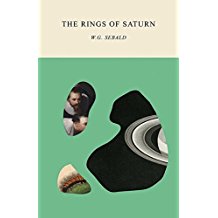The Rings of Saturn, W.G. Sebald, 1995
This is a spell-binding book in which Sebald, who died tragically at age 57 in 2001 in an auto accident, uses the same techniques we saw in The Emigrants to create a mysterious, modernist travelogue through space and time. Beginning with his description of a series of walks along the sea coast in Suffolk, from Lowestoft to Felixstowe, the narrator takes the reader on a fascinating series of unrelated tangents. The narration is taken up by characters as diverse as Thomas Browne (17th C physician and scientist, 1605-1682), Joseph Conrad, Comte de Chateaubriand and we learn about the North Sea herring industry, silkworm production in Germany, the Chinese imperial succession during and after the Opium Wars, Swinburne, the Irish Troubles, Napoleon and Waterloo, Edward Fitzgerald the English translator of the Rubaiyat of Omar Kayyham, and countless details of the less important people, places, and stories that Sebald encounters on his journey, the explanation for which is never given. The ‘connections’ in this novel are somewhat daunting. First, Jane Gardam in her Old Filth trilogy seems to draw upon Sebald since Terence Veneering’s (shares a name of the main character in Dickens’ Our Mutual Friend) hometown of Herringfleet makes an appearance as does Veneering’s place of death, Malta. One of his characters visits Patmos’ ‘dark grotto’ which Molly and I visited on our Yale trip. The narrator stays at the Albion Hotel in Lowestoft and Susan and I will stay at the Albion Hotel in Miami Beach next week, and on and on and on. Borges and his labyrinth, Kafka and his dislocating metamorphosis, Descartes, Roger Casement (Irish patriot and English colonial critic), Rembrandt (and his painting with meaning rather than accuracy), Buffon (and his calculation of pi=2L/xP), Gavrilo Princip (assassin of Archduke Ferdinand), Kurt Waldheim (in a swipe at the ability of modern Austria to forget its Nazi past) and Durer all make cameo appearances. Classical references abound including the very obscure: the two pilots whose deaths the gardener at Somerleyton recalls from WWII were from Versailles, KY and Athens, GA. The dislocation of emigration, the unreliability of memory, the connectedness and paradoxical randomness of all of life and living, anniversaries and dates of birth and death all contribute to Sebald’s dreamlike and mysterious aura. Sebald points out the ‘iniquity of oblivion” and ‘It takes just one awful second …and an entire epoch passes’ in reference to Somerlyton Hall and the formerly grand era of the late 19th All of life is transitory and we are all doomed to be forgotten. Other than that, it’s a cheery book. Sebald’s use of photographs is wonderful including one of him in front of a huge tree that the hurricane of 1987 took down. Everything passes…..



